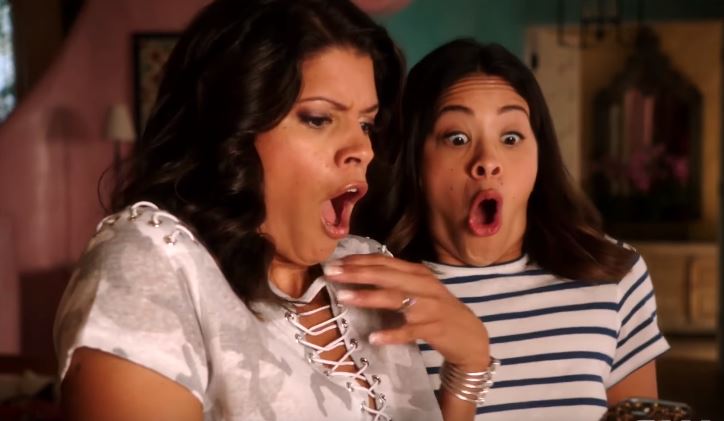Life as A Telenovela

Image via Youtube. / CC BY-NC 2.0
(This article contains spoilers for “Jane the Virgin”)
When “Jane the Virgin” initially premiered on the CW in 2014, I didn’t care much about starting Jane Villanueva’s story. Though it promised Latinx representation, I gathered from the advertisements that it would be a cheesy show that spotlighted the titular character’s sexuality and humorized an unexpected pregnancy. It had marketed itself into a corner that I could not relate to nor find interest in. But several months later, peer pressure eventually broke me and I found myself binge-watching the first two seasons. It was then that I realized two things. One, “Jane the Virgin” appears in TV spots as a colorful exploration of the protagonist’s whirlwind, comical misfortune, and that is exactly what it is. Though the commercials fail to include the nuance, backbone, and guitar strums that usually accompany each episode, they trickle down to what is at the forefront of the series. My second realization was that, despite the murders in hotels, long-lost twin sister reveals, and, most notably, accidental artificial inseminations by distraught sisters-of-baby-fathers, I had never related to a show so much in my life.
Every episode of “Jane the Virgin” begins with a sentimental flashback to the titular character’s past, drawing the audience into a brief storyline that somehow relates to present-day Jane’s struggles. Clips include moments such as Jane’s ceremonial crushing of a white flower, a house party noise-complaint-turned-romance, and watching Fourth of July fireworks with family. For me, these were all entertaining to watch and were educational about character motivations, making me bite my tongue whenever I wanted to criticize Jane or her family’s decisions. But there was also power in the softer moments where much didn’t happen.
Many of these flashbacks center on Jane’s relationship with the two most important women in her life and some of the relatively trivial flashbacks tend to expound on those relationships. Young Jane sits between her mother, Xo, and grandmother, Alba, watching a telenovela in one of many flashbacks that start this way. What this clip explains to us is the magic that Jane finds in romance and how she has always loved it. These moments serve as a playing ground for the upcoming turmoil in that night’s episode, but also unravel a bit of the fabric that keeps “Jane” and our world apart. The insertion of small details like a child enjoying television in the company of family members calls to viewers’ nostalgia and recognition of universal feelings of comfort.
In their serene moments, the Villanueva women are touching, but in their unlikable moments, the women are authentic. Another flashback shows Jane’s many birthday parties and Xo, being the relatable and hip parent she is, gets intoxicated and dances, embarrassing her daughter. Even Xo, in her youth, fails to cheer Alba up on the anniversary of her late father’s death, and acts out in order to get her mother’s attention. The simple yet consistent arrangement of generations of feuding Villanueva women in flashbacks gives us a door into their world, a moment in vulnerability in which viewers can insert themselves in this story.
And even if the Villanueva women’s openness with each other doesn’t garner the most moving reaction in an episode—though it is undoubtedly the core of the show—there is something to be said about the series’s recognition of identity. Jane is a woman of color, born to a working-class, immigrant family. Not once has the show let us forget Jane’s social position in the world as a Venezuelan woman who has a toddler and a less-than-ideal job. And though, no, most people watching the show are probably not twenty-somethings with a telenovela star as a dad and dead husbands that return from the dead, there is still a prevailing sense of relatability that shines through.
Jane is a character born and cultivated on the idea of hope. Her character constantly embodies hope and passion, something the show likes to visually present through glowing hearts. I found that I could relate to Jane’s struggles with writing her novel. Jane’s motivations are clear: she wants to create art that people love as much as she does. Every up and down Jane has with writing, from writer’s block to looking for an agent to sadness over bad book reviews, has meant something to me even though I’m not necessarily in her position. It is the way Jane approaches each situation, with some of the same doe-eyed excitement present in the flashbacks, that make me feel as if Jane represents my evolution. There is a grounding component in her unencumbered faith in destiny that is encouraging in helping viewers forget their fears.
Superficially, Jane does have some outrageous storylines that usually lead weekly reviews of episodes. But the double-edged sword is how each of these events somehow contain elements of realism. “Jane the Virgin” consists of enough storylines to build an empire. For me, I found myself in the in-between moments, like stories of family members’ immigration to America, until the plot began to lend to some scarily accurate parts such as the book-writing and the cancer storyline. But, if anything, the breakneck plot twists in “Jane” are what keep it an accurate representation of our world.
There is a continuum that ranges from fiction to nonfiction and by pushing the scale in a third direction, “Jane” ultimately falls in its own category of truth that redefines real life. I don’t mean to make this a “representation matters” piece, but it does, not just to those within the narrative, but to those who don’t expect to be.




